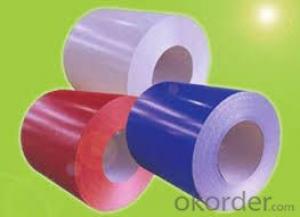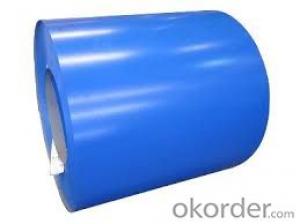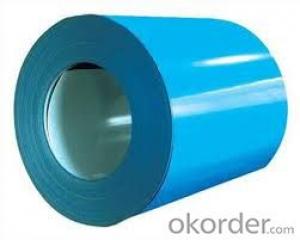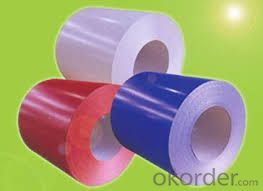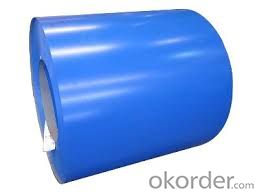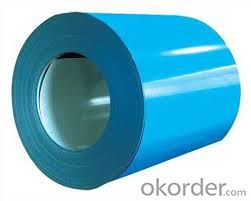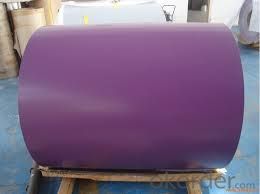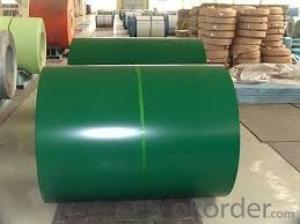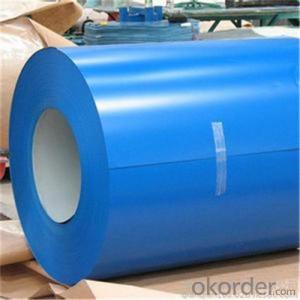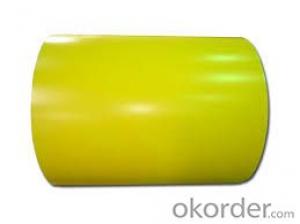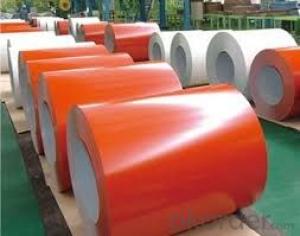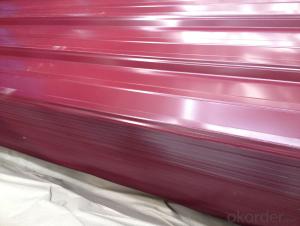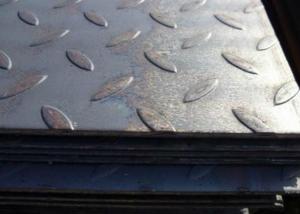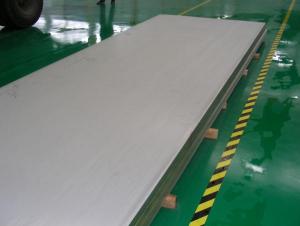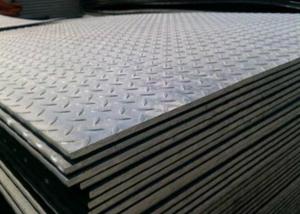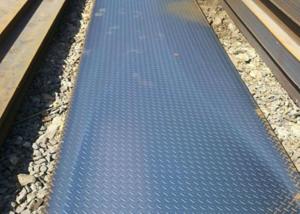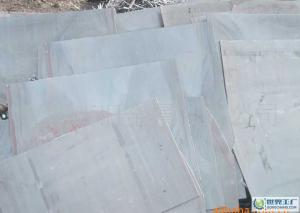Prepainted galvanized corrugated plate / sheet in China
- Loading Port:
- Tianjin
- Payment Terms:
- TT OR LC
- Min Order Qty:
- 100 m.t.
- Supply Capability:
- 500000 m.t./month
OKorder Service Pledge
OKorder Financial Service
You Might Also Like
Brief Introduction of Prepainted Galvanized Steel:
Prepainted Galvanized Steel usually refers to have substrate processed with surface processed and coated then(roller coated )or bonded organic thin film and baked, and it is able to be processed to final production .
Prepainted Galvanized Steel qualified with excellent decorative, formability, corrosion resistance, coating adhesion ,can keep for a long time as well as maintain fresh color .For color coated steel sheet can obtain good economic benefit by steel belt wood ,efficient in construction and save energy ,prevent pollution etc. Which is an ideal material; for manufacturing board.
Description of Prepainted Galvanized Steel:
1.material : galvanized steel sheet / prepainted galvanized sheet
2.sheet thickness : normal use 0.3-0.6mm
3.length: any length, according to the transportation, generally less than 12m
4.color: standard color: red, blue, white, grey; special color: according to RAL color
Specification of Prepainted Galvanized Steel:
prepainted corrugated steel plate | |
material | galvanized steel sheet |
prepainted galvanized sheet | |
model No. | types of roof sheets |
sheet thickness | normal use 0.3-0.6mm |
length | any length, according to the transportation, generally less than 12m |
color | standard color:red, blue, white, grey |
special color: according to RAL color | |
characteristic | 1:weather proof |
2:heating insulation | |
3:fireproof | |
4:anti-rust | |
5:sound insulation | |
6:long life span: more than 15 years | |
advantages | 1.low foundation cost |
2.easy construction | |
3.time saving | |
4.labor saving | |
application field | 1:construction:prefabricated house, steel house, mobile house, modular house, villa, bungalow design, portable house/carbin, ready made house, kiosk booths, steel building... |
2:container manufacturing | |
3:household appliances and furniture | |
4:vehicle and vessel manufacturing | |
5:others,like machinery structual parts, manufacturing shells of motors and so on | |
packing | plastic film, pallet or as your request |
Applications of Prepainted Galvanized Steel
It can be widely used in transportation, light industry, civil usage and farming. It is also the perfect building material in construction for making steel roofing, insulation panel, corrugate sheet, facade wall, shutters, T-bar and home appliance.
Packaging & Delivery of Prepainted Galvanized Steel
The packing of coils consists of anti-damp paper, PVC film, hardboard paper, steel box, strapped with steel strips, fitted with locks and edge protectors and guarantees the optimal condition of the delivered goods. Each coil can be additionally fitted with wooden/steel skids(eye to the side) or wooden pallets(eye to the sky).
Images of Prepainted Galvanized Steel:
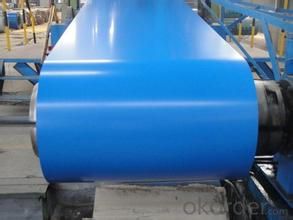

- Q: How do steel sheets compare to other materials, such as aluminum or copper?
- There are several advantages to using steel sheets instead of materials like aluminum or copper. Firstly, steel is known for its exceptional strength and durability, making it able to withstand heavy loads and resist impacts better than aluminum or copper. This makes steel sheets perfect for applications that require high strength and structural integrity, such as in construction or the automotive industry. Furthermore, steel sheets have a higher melting point than aluminum or copper, meaning they can withstand higher temperatures without deforming or melting. This makes steel sheets suitable for applications that involve exposure to high temperatures, like in manufacturing processes or engine components. Additionally, steel sheets have excellent corrosion resistance properties. They can be coated with protective layers like zinc or chromium to enhance their resistance to rust and corrosion. In contrast, aluminum and copper are more prone to corrosion, especially when exposed to certain environments or chemicals. This makes steel sheets the preferred choice for outdoor applications or structures that need long-term durability. Another advantage of steel sheets is their cost-effectiveness. Steel is relatively cheaper compared to aluminum or copper, especially when considering its strength and durability. This makes steel sheets a more economical choice for various applications where cost is an important factor. However, it is important to note that aluminum and copper also have their own advantages. Aluminum is lightweight and has excellent thermal conductivity, making it suitable for applications that require lightweight materials or efficient heat transfer. Copper, on the other hand, has superior electrical conductivity, making it ideal for electrical wiring or components. In conclusion, steel sheets offer exceptional strength, durability, corrosion resistance, and cost-effectiveness compared to aluminum or copper. However, the choice of material ultimately depends on the specific requirements of the application, such as weight, thermal or electrical conductivity, and environmental factors.
- Q: What are steel sheets?
- Steel sheets are flat, thin pieces of steel that are made by rolling or pressing steel into different shapes and sizes. They are commonly used in construction, manufacturing, and other industries for various applications such as building structures, automotive parts, and appliances.
- Q: Are steel sheets suitable for cryogenic applications?
- Yes, steel sheets are suitable for cryogenic applications. Steel is known for its high strength, toughness, and durability, which makes it capable of withstanding extreme cold temperatures. Additionally, steel is resistant to thermal stress and exhibits good thermal conductivity, making it a suitable material for cryogenic storage tanks, pipelines, and other cryogenic equipment.
- Q: Can steel sheets be used for heat transfer applications?
- Yes, steel sheets can be used for heat transfer applications due to their high thermal conductivity and ability to withstand high temperatures. They are commonly used in various industries, such as HVAC systems, automotive manufacturing, and power generation, for efficient heat transfer and dissipation.
- Q: What is the typical elongation of a steel sheet?
- The typical elongation of a steel sheet can vary depending on the specific grade and thickness of the sheet. However, as a general guideline, the typical elongation for a steel sheet can range from 20% to 40% before it reaches its breaking point.
- Q: Can steel sheets be used for storage containers?
- Certainly, storage containers can indeed utilize steel sheets. Steel, being an incredibly robust and long-lasting substance, possesses the ability to endure substantial burdens and adverse weather conditions, rendering it exceptionally suitable for storage containers. It provides exceptional safeguarding against dampness, pests, and theft. Steel containers are extensively employed across a multitude of sectors, namely shipping, construction, and warehousing. Moreover, they are highly favored for transient storage resolutions, as they can be effortlessly transported and stacked. Furthermore, steel containers can be tailored to specific storage requirements through the incorporation of diverse accessories such as doors, windows, and ventilation systems.
- Q: Do steel sheets have any environmental benefits?
- Steel sheets possess numerous environmental advantages. Firstly, steel is an immensely recyclable material, allowing for multiple reuses without compromising its quality. This notably diminishes the necessity for new steel production, subsequently reducing the extraction of raw materials and the energy consumption associated with manufacturing. Additionally, recycling steel aids in the reduction of greenhouse gas emissions and the preservation of natural resources. Moreover, steel sheets exhibit exceptional durability and longevity. Their high resistance to corrosion means they require minimal maintenance throughout their lifespan. This durability lessens the need for frequent replacements, ultimately decreasing the demand for new steel production and its accompanying environmental impact. Furthermore, steel sheets can contribute to energy efficiency in buildings. When utilized as roofing or cladding material, they provide excellent insulation properties, effectively reducing the requirements for heating and cooling energy. Consequently, this leads to lower energy consumption and a reduced carbon footprint. Additionally, steel sheets possess fire-resistant qualities, thereby enhancing building safety and minimizing the risk of fire-related accidents. This aspect positively impacts the environment by minimizing the release of harmful emissions and pollutants resulting from fires. In conclusion, steel sheets present a range of environmental benefits, encompassing recyclability, durability, energy efficiency, and fire resistance. These attributes contribute to a more sustainable and eco-friendly approach within the construction and manufacturing industries.
- Q: What are the different edge treatments for steel sheets?
- Steel sheets can be treated with various edge techniques depending on the desired functionality and aesthetics. Some common treatments for steel sheets include: 1. Deburring: To enhance safety and prevent injuries during handling and installation, any burrs or sharp edges formed during manufacturing are removed. 2. Beveling: Creating a sloping edge on the steel sheet facilitates welding or joining multiple sheets. Beveled edges provide a smooth transition and strengthen the joint. 3. Chamfering: For a polished and finished look, a beveled edge is created on the steel sheet, primarily for aesthetic purposes. 4. Hemming: In the automotive and appliance industries, the edge of a steel sheet is bent back onto itself to create a safe and smooth edge, eliminating the need for additional finishing or edge protection. 5. Rolled edges: The edge of the steel sheet is bent in a curved or rounded shape to enhance structural integrity, reduce the risk of injury, and improve the overall appearance. 6. V-grooving: A V-shaped groove is cut along the edge of the steel sheet, commonly used for decorative purposes or to create a clean and precise joint when joining multiple sheets. 7. Flanging: The edge of the steel sheet is bent or folded at a specific angle to increase rigidity and strength, particularly in applications where the sheet needs to support weight or resist bending. Each edge treatment serves a specific purpose and should be chosen based on project requirements, considering factors such as functionality, safety, aesthetics, and ease of fabrication.
- Q: What is the recommended storage method for the steel sheets?
- To effectively store steel sheets, it is recommended to place them in a well-ventilated and dry location. It is crucial to keep the sheets away from both moisture and direct sunlight, as these factors may lead to rust and material degradation. By stacking the sheets on pallets or racks with adequate spacing between them, potential damage can be prevented. Furthermore, it is advisable to cover the sheets with a protective material like a tarp or plastic wrap to provide additional protection against dust and other contaminants. To maintain their longevity and usability, regular inspection and maintenance of the storage area, along with maintaining an inventory of the sheets, are highly recommended.
- Q: Can steel sheets be used in aerospace applications?
- Yes, steel sheets can be used in aerospace applications. However, their usage is limited due to factors such as weight and strength requirements.
Send your message to us
Prepainted galvanized corrugated plate / sheet in China
- Loading Port:
- Tianjin
- Payment Terms:
- TT OR LC
- Min Order Qty:
- 100 m.t.
- Supply Capability:
- 500000 m.t./month
OKorder Service Pledge
OKorder Financial Service
Similar products
Hot products
Hot Searches
Related keywords
